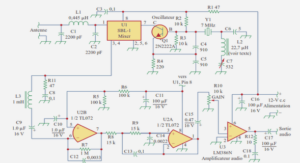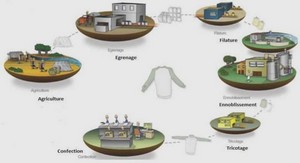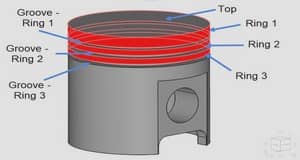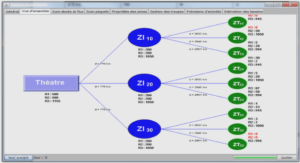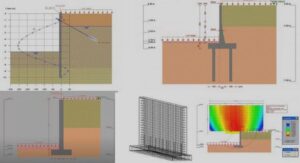Télécharger le fichier original (Mémoire de fin d’études)
Interrill erodibility parameter in soil erosion models
Three different determination methods of interrill soil erodibility have been identified based on a literature review of erosion models: (i) standard erosion plots and derivation,
(ii) splash cups, and (iii) aggregate stability tests. Table 1.1 shows the analyzed models and the erodibility assessment method.
Standard erosion plots and derivations
In models based on or derived from the USLE (Universal Soil Loss Equation), a single erodibility value combining interrill and rill processes is inferred from the soil loss mea-sured at the end of a standard erosion plot that is 22 m long and has a 9% gradient. In these standard conditions, other factors of the USLE (L, S, C and P) are considered unitary, and the factor K is defined as the slope coefficient between soil loss and R (the rainfall erosivity index). In practical terms for the USLE and the RUSLE (Re-vised Universal Soil Loss Equation), soil erodibility is the average long-term soil and soil-profile response to the erosive power of rainfall. This means that the soil erodibil-ity factor for the USLE is a lumped parameter that represents an integrated average annual value of the total soil profile reaction to a large number of hydraulic and erosive processes. These processes include rainwater infiltration into the soil profile, raindrop detachment with transport by raindrop splash (RD-ST), raindrop detachment with transport by raindrop-induced flow transport (RD-RIFT), raindrop detachment with transport by flow (RD-FT), flow detachment with transport by flow (FD-FT) (Kin-nell, 2005), and localized deposition due to topography and tillage-induced roughness (Wischmeier, 1976). Normally, the measurements of soil loss and R are annual means as mentioned above, and their application to single event models is not necessarily rel-evant. Actual references for K come from a series of experiments over periods of 20 years in the eastern United States. Such experiments are expensive, and therefore few of them were conducted in other areas of the world. Rainfall simulations make it possible to perform many more experiments concerning soil erodibility determination. These experiments facilitate the establishment and measurement of empirical relationships between soil erodibility and other primary soil properties. From a statistical analysis of all these standard plot results, Wischmeier et al. (1971) proposed a nomograph where the erodibility factor is first a function of soil characteristics, such as texture and or-ganic matter content, and second one of soil properties, like structure and permeability. The algebraic function of the nomograph is shown in eq.(1.1).
The erodibility values range from [0.07- 1.0 ton •ha−1 ], with higher values for loam and sandy-loam and lower values for sand. In unit plot measurements, clay soils have medium soil erodibility, because they have good resistance to detachment by flow. However, sandy soils have the lowest soil erodibility values as shown in Figure 1.1.
Interrill erodibility parameter in soil erosion models
In fact, soils produce less sediment because of reduced runoff that results from high infiltrability; soil particles could be detached and splashed easily. However, sandy soils also have low transportability, and little runoff is available to detach and transport soil particles. The transport limitation of coarse-size particles has been observed by (Parsons et al., 1991) on a 35×18 m2 plot. However, when runoff comes from upslope, sand may be very prone to erosion (Toy et al., 2002). Erodibility from standard plots as USLE was designed to allow prediction of soil erosion and recommendations for applying conservations practices.
Among the models based on standard erosion plots and their derivations, the WEPP (Water Erosion Prediction Project) is based on a particular concept of soil erodibility. It uses two erodibility parameters: one related to rill processes and another one related to interrill processes. The interrill erodibility parameter is determined using a mini-plot (0.6×1.2 m) without vegetation that is submitted to rainfall simulation. Like the erodibility from standard erosion plots, the measurement is made over the erosion rate and converted to erodibility. The WEPP interrill soil erodibility parameter is calculated with:
Di (1.2)
Ki = I2 • Sf
where, Di is the delivery of sediment from plot (kg.m−2 .s−1 ), Ki is interrill erodibility (kg.m−4 .s), I is the effective rainfall intensity (m.s−1 ), and Sf is a slope adjustment factor given by Sf = 1.05 − 0.85e−4sin(α) where α is the slope of the surface toward a nearby rill.
As with erodibility from standard erosion plots, the WEPP model has developed an indirect way to determine soil interrill erodibility as a function of primary soil properties. For croplands, the erodibility values are based on experiments conducted in 1987 and 1989 by Elliott et al. (1989). Two different empirical equations of interrill soil erodibility were developed for croplands: one composed of soil with 30% or more sand (eq.(1.3)) and another for the soils with 30% or less sand (eq.(1.4)). The equation for the baseline (standard) erodibility is shown below.
Kib = 2728000 + 19210000 • vfs (1.3)
Kib = 6054000 − 5513000 • clay (1.4)
where vfs is the very fine sand (0.05 to 0.15mm) in the surface soil, and clay is the fraction of clay in surface soil.
The interrill erodibility equation for croplands uses the baseline erodibility with correction factors to account for various effects, including canopy cover, ground cover, roots, and sealing and crusting. These factors are calculated empirically and multiplied by the interrill baseline erodibility to find the adjusted interrill erodibility for croplands.
The suggested limit for the predicted values of erodibility to croplands is [0.5-12] in (106 .kg.m−4 .s). In Figure (1.2) and Table (1.2) the range of values is [0.77-4.5 106 .kg.m−4 .s], with the highest values for silty-loam and the lowest values for sandy-loam. Observing erodibility values from the standard erosion plot and mini-plot meth-ods we note that the dependence of hydrological phenomena is maintained and that the capacity of soil runoff production is a very important factor.
Splash cups
A second method currently used for determining interrill soil erodibility is based on the measurement of soil detachability. This approach derives from the pioneer work of Ellison (1947). Several techniques have been developed to measure soil detachability using raindrops. One consists in embedding a circular cup into the topsoil in order to collect the soil particles that detach from the surrounding surface by the kinetic energy of rainfall (Bollinne, 1975; Savat and Poesen, 1981). Another procedure used to measure soil detachment with splash cups is the reverse of that previously shown: it consists in filling a cylinder with soil and measuring the mass of the sediment that detaches from this cylinder by rainfall kinetic energy (Morgan, 1978). In these two cases, raindrop detachment with transport by raindrop splash (RD-ST) is the only process involved. In addition the two type of tests generally use a little amount of soil.
Sreenivas et al. (1947) used round cups or funnels embedded in the soil to catch splashed particles. They considered the mass of the collected material divided by the surface area of the cup (with radius r in m), denoted here by mr, as an indicator of the detachment rate on the surrounding soil. This method has been applied in subsequent studies, a number of which were reviewed by Poesen and Torri (1988). The index of detachability is determined by: k = mr (1.5) where k is the detachability index (g.J−1 ) , mr is the mass of soil particles detached (g) and, KE is the total rainfall kinetic energy (J).
However, the splash rate (mr) is dependent on the cup size, and the relationship be-tween the cup size and splash rate is also influenced by the distribution of the distances over which the splashed particles travel. Given a particular amount of soil detached per unit of area outside the cup, more sediment will end up in the cup as the distance over which splashed particles travel increases. Poesen and Torri (1988) developed a correction factor for the splash cup diameter effect based on Savat and Poesen (1981) that had shown the mass of deposited splashed sediment decreases exponentially with the distance to the impact point. The equation developed by Poesen and Torri (1988) is shown in eq.(1.6). msr = mr • e−0.054D (1.6) where msr is the real mass of splashed soil material per unit area (g.cm−2 ) and D is the splash cup diameter (cm).
However, there are many geometric possibilities for the splash cups and comparing results from different geometry is very difficult. Therefore each one of the device’s geometry has its own correction function. Poesen and Torri (1988) proposed to measure splash detachment in a field using a circular cup with a diameter larger than 10 cm in order to reduce the edge effect.
The analysis of splash processes and modeling was further refined by Legout et al. (2005); Van Dijk et al. (2002) and Leguédois et al. (2005) . These studies established theoretical splash distribution functions to interpret results from different experiments.
However, the literature does not provide enough references to the erodibility values of the splash cup method to establish a statistical analysis. Morgan (2001) proposed reference values for erodibility from splash cups; these values are shown in Figure 1.3 and Table 1.3 . Unfortunately these are only average values, and we have no information about their variability for either the texture classes or the number of soils tested.
The theoretical range of values for erodibility from splash cups is [0.01-10 g.J−1 ] (Morgan, 2001; Morgan et al., 1998a). The real observed range of values is [0.05-1.2 g.J−1 ] with a maximum value for sand and a minimum value for clay.
Aggregate stability tests
A third method used for the determination of interrill soil erodibility is based on the measurement of soil aggregate stability. In the LISEM (Limburg Soil Erosion Model) (De Roo et al., 1996b), this parameter is determined with a drop test that consists in counting the number of drops necessary to reduce the mass of an aggregate by 50%. The range of value for aggregate stability is [1 to 200 or more] drops according these authors. It is important to note that the number of drops is inversely proportional to soil resistance. A complete experimental set of values for soil textures is not available in the literature; however, some papers such as (Dijk et al., 1996; Hessel et al., 2006; Liu et al., 2003) present aggregate stability values for different soil treatments and land-uses.
Hessel et al. (2006) present a set of values for clay loam soils submitted to different agricultural cultures in east Africa (coffee, banana, vegetables, wood plots, and maize). The erodibility values found by Hessel et al. (2006) for clay loam soils range from 22 to 376 drops; the lowest value is for coffee and the highest value is for wood plots.
Liu et al. (2003) present a set of values for silt soils submitted to different soil uses in the Chinese Plateau (steep slope, terrace, cropland, woodland, fallow and wasteland). The values of soil erodibility vary from 8 to 18 drops with cropland having the lowest value and woodlands the highest. Dijk et al. (1996) present a set of values for silt soils submitted to different uses in South Limburg. The values of erodibility from this work range from 10 to 30 drops.
In addition to the drop test method, there are many other methods that can de-scribe soil aggregate stability. Amezketa (1999) reviewed these methods. Le Bissonnais (1996) proposed a standardized method based on the most common and reproducible aspects of the classical methods of erodibility assessment. Le Bissonnais’s method uses relatively large aggregates (3-5 mm), and performs various tests corresponding to different conditions of water impact on soil. These tests represent the mechanisms of aggregate breakdown in natural conditions, from intense rainstorms on dry soils to long low intensity rains on wet soils. Although the measurement of the aggregate stability of some isolated samples does not completely characterize a soil material submitted to erosive stress, it generally correlates well with the erosion measured on plots in con-trolled conditions or in the field (r = -0.85 from Amezketa et al. (1996) and r = -0.70; p > 0.01 from Barthés et al. (2000)). This has to be related to the fact that desaggrega-tion, which is measured in the aggregate stability test, is most often the main process involved in soil erosion and particularly in interrill erosion (Bryan, 2000). However, some authors found no correlation between stability and measured erosion (Young, 1974). In some cases these results correspond to specific situations where runoff rate is high that it can transport stable micro- or macro-aggregates(Janeau et al., 2003). The intensity of the correlation between the erosion and aggregate stability also depends on the methods used for both measurements. For example, the smaller the aggregates used for stability tests, the greater the chance of erosion to affect stable aggregates and thus the chance for a contradiction between stability and erosion. It has been shown that stronger correlations between measured interrill erosion and aggregate stability were observed when using Le Bissonnais’s test compared to other classical methods (Amezketa et al., 1996; Le Bissonnais et al., 2007). However, no erosion model using an aggregate stability tests like the erodibility parameter was found in the literature, although Yan et al. (2008) successfully used it as a substitute for the interrill erodibility parameter Ki that was considered irrelevant for an application of WEPP model.
Because of the absence of a sufficient data set for the drop test, only aggregate stability values from the Le Bissonnais method were plotted in figure 1.4 using data from table 1.4 . The results of the tests are plotted in 1/MWD (Mean Weight Diameter) to give the same aspect of for all of the presented erodibility graphics (high values indicate high erodibility).
Table des matières
Introduction Générale
1.1 Contexte et problématique
1.2 Objectifs
1.3 Plan de la thèse
I Analyse bibliographique sur certains concepts pour la modélisation de l’érosion
Introduction
1 Soil Resistance to Interrill Erosion: Model Parameterization and Sensitivity
1.1 Introduction
1.2 Interrill erodibility parameter in soil erosion models
1.2.1 Standard erosion plots and derivations
1.2.2 Splash cups
1.2.3 Aggregate stability tests
1.2.4 Discussion on erodibility assessment methods
1.3 Models of sensitivity to interrill erodibility
1.4 Numerical comparison of three major interrill erodibility assessment methods
1.5 Discussion and Conclusion
2 Interface Effects on Sedimentological Connectivity of Agricultural Catchments in Erosion modelling: A Review
2.1 Introduction
2.2 Interfaces effect on sedimentological connectivity in agricultural landscape
2.2.1 Interfaces in agricultural landscape
2.2.2 The case of vegetative filters (VF)
2.2.2.1 Experimental aspects
2.2.2.2 Theoretical aspects
2.2.2.3 Modelling aspects
2.2.3 Upscaling sedimentological connectivity from plot scale to catchment scale
2.3 Sedimentological connectivity of agricultural landscape in catchments scale erosion modelling
2.3.1 Catchment scale models that apply USLE P-factor approach
2.3.2 Catchment scale erosion model using SDR and Derivations
2.3.3 Catchment scale erosion model using specific physical parameters
2.3.4 Comparison of sedimentological connectivity modelling approaches in catchment erosion models
2.4 Conclusion
Conclusion et conséquences pour les choix d’une modélisation
Synthèse sur les paramètres d’érodibilité
Synthèse sur l’effet des interfaces sur la connectivité sédimentologique
Conséquences pour les choix d’une modélisation
II Modélisation
Introduction
Protocole de modélisation
3 Le modèle hydrologique MHYDAS
3.1 Rappel sur le modèle hydrologique MHYDAS
3.1.1 Structure du modèle
3.1.2 Segmentation de l’espace
3.1.3 Processus hydrologique
3.1.3.1 Le calcul du ruissellement
3.1.3.2 La propagation du ruissellement sur une unité de surface
3.1.3.3 Les échanges nappe-tron¸cons de réseau hydrologique
3.1.3.4 Propagation `a travers le réseau hydrographique dans MHYDAS
4 MHYDAS-Erosion: A physically based spatially distributed erosion model for agricultural catchment application
4.1 Introduction
4.2 Model Description
4.2.1 Model summary
4.2.2 Spatial segmentation
4.2.3 Hydrological processes represented in the model
4.2.3.1 Rainfall-Runoff model
4.2.3.2 Transfert model in rill and reach elements
4.2.4 Erosion processes represented in the model
4.2.4.1 Soil detachment and transport by rainfall
4.2.4.2 Soil detachment and transport by runoff
4.2.4.3 Sedimentological connectivity
4.2.5 Numerical methods
4.3 Model Testing
4.3.1 Test procedure
4.3.2 Study area
4.3.3 Statistical evaluation
4.3.4 Model parameterisation
4.4 Results and discussion
4.5 Conclusion
III Analyse de sensibilité et exploration du modèle
Introduction
5 Sensitivity analysis of distributed erosion models – I. Framework
5.1 Introduction and scope
5.1.1 Position regarding hydrology-erosion models
5.1.2 Position regarding sensitivity analysis practices
5.1.3 Position regarding sensitivity measure and representation
5.1.4 Sensitivity to spatial distributions of parameters
5.2 Materials and methods
5.2.1 Virtual Catchment
5.2.2 Classification of the parameters
5.2.3 Spatial distributions of the parameters
5.2.4 Resolution scheme
5.2.5 Sensitivity calculations
5.2.6 Sensitivity to spatial distributions
5.2.7 Sensitivity to flow aggregations
5.2.8 Stages of the procedure
5.2.8.1 Objectives
5.2.8.2 Preliminary stage
5.2.8.3 Individual one-at-a-time tests
5.2.8.4 Rules to form super-parameters
5.2.8.5 Exploration of super-parameter space
5.2.8.6 Adaptations for spatially-distributed configurations
5.3 Results and representation
5.3.1 Spatially-homogeneous configurations
5.3.2 Spatially-distributed configurations
5.3.3 Sensitivity maps
5.4 Conclusion
6 A framework for sensitivity analysis of distributed physics based erosion models II: Application to four Distributed Erosion Models
6.1 Introduction
6.2 Materials and methods
6.2.1 Models
6.2.2 Virtual Catchment and Parameterization
6.2.3 Equivalent Parameters
6.2.4 Screening and Sensitivity Indices
6.3 Results and Discussion
6.3.1 Spatially-homogeneous Configurations
6.3.1.1 MHYDAS-Erosion
6.3.1.2 STREAM
6.3.1.3 PESERA
6.3.1.4 MESALES
6.3.1.5 Sensitivity Maps
6.3.2 Spatially-distributed Configurations
6.3.2.1 MHYDAS-Erosion
6.3.2.2 STREAM
6.3.2.3 PESERA
6.3.2.4 MESALES
6.3.2.5 Sensitivity Maps
6.3.3 Summary of Comparative Results
6.4 Conclusion
7 Sensibility analyses of a Water Erosion Model to the Spatial Distribution of Land Management Practices
7.1 Introduction
7.2 Material and Methods
7.2.1 Study site
7.2.2 The erosion model
7.2.3 Sensitivity analysis procedure
7.2.3.1 Stochastic model of LMP upstream-downstream distribution
7.2.3.2 A framework to link stochastic model to MHYDASErosion
7.2.3.3 Principles of global sensitivity Sobol indices calculation
7.3 Results
7.3.1 Model response to upstream-downstream position
7.3.2 Sobol’s sensitivity indices results
7.4 Discussion and Conclusion
8 Multi-scale Calibration and Validation of a DistributedWater Erosion
Model: Application in a Mediterranean Vineyards Catchment
8.1 Introduction
8.2 Material and Methods
8.2.1 Study site
8.2.1.1 The measurement devices
8.2.2 Rainfall events
8.2.3 Model description
8.2.4 Model calibration and validation procedure
8.2.4.1 Calibration parameters
8.2.4.2 Automatic calibration procedure with PEST
8.3 Results
8.4 Discussion and Conclusion
9 Conclusion Générale, Réflexions et Perspectives
9.1 Introduction
9.2 Conclusion sur la conceptualisation et le développement de la modélisation de l’érosion
9.2.1 L’érodibilité interrill (érosion diffuse)
9.2.2 Connectivité sedimentologique
9.2.3 Développement de la modélisation
9.3 Conclusion sur l’analyse de sensibilité et l’analyse exploratoire du modèle
9.3.1 L’analyse de sensibilité
9.3.1.1 Cadre pour l’analyse de sensibilité, développement et application
9.3.1.2 Sensibilité de MHYDAS-Erosion `a la position amontaval des aménagements
9.3.2 Calage et validation
9.4 Réflexions
9.5 Perspectives
References

